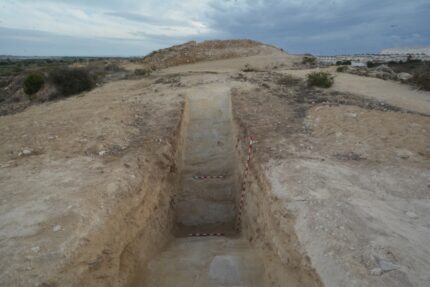Archaeologists have discovered the remains of an ancient moat at the Phoenician site of Cabezo Pequeño del Estaño in the southeastern coast of Spain. The moat is about 10 feet deep and 26 feet wide at the top and was part of the defensive systems of the 8th century B.C. Phoenician citadel. It is the only Phoenician moat from its age known to exist in the western Mediterranean. The only other comparable structures are in Phoenician cities like Tel Dor, Israel, and Beirut, Lebanon.
The site was founded in the 8th century B.C. by Phoenician merchants who traveled from the Mediterranean up the Segura River. They built a citadel on the banks of the river in around 770-750 B.C., following a well-planned urban template seen in other Phoenician colonies. Excavation of the settlement area has revealed the presence of commercial concerns — storage structures, warehouses, metallurgic workshops, forges, furnaces — and residences — a large roundhouse with adobe benches, other dwellings.
A multi-disciplinary team from the University Institute for Research in Archeology and Historical Heritage (INAPH) of the University of Alicante and the Archaeological Museum of Guardamar (MAG) have been excavating the site since 2013, focusing on getting a wide picture of the defensive structures, long obscured by sedimentary deposits, natural erosion and damage wrought by a quarry that destroyed much of the town in the 1990s.
Aerial photography first detected evidence of a moat running parallel to the citadel wall. This year’s excavation confirmed it was indeed a defensive moat, painstakingly cut out of the living rock by hand. Chisel marks are clearly visible in the substrate.
This exceptional find confirms the challenges encountered by Phoenician settlers on the Iberian coast. They encountered enough hostility from the locals to justify the massive effort expended in carving out and building a heavily fortified settlement at Cabezo Pequeño del Estaño. The natural resources of the area, primarily metal mining (Cabezo Pequeño del Estaño means Little Head of Tin) made it worth their while. For a few decades, at least. The town was abandoned around 700 B.C.

The famous ‘Lady of Elche’ (4th century BC) from Alicante in Valencia may suggest Hellenistic influences, but maybe Phoenician ones as well.
——-
Pliny, ‘Natural History’, 2.67: “While the power of Carthago was at its height, Hanno published an account of a voyage which he made from Gades [Cádiz] to the extremity of Arabia; Himilco was also sent, about the same time, to explore the remote parts of Europe.”
Herodotus ‘Histories’, 4.42.: “I wonder then at those who have parted off and divided the world into Libya, Asia, and Europe, since the difference between these is not small; […] for Libya furnishes proofs about itself that it is surrounded by sea, except so much of it as borders upon Asia; and this fact was shown by Pharaoh Necho first of all those about whom we have knowledge. He when he had ceased digging the channel which goes through from the Nile to the Arabian gulf, sent Phenicians with ships, bidding them sail and come back through the Pillars of Heracles to the Northern Sea and so to Egypt. The Phenicians therefore set forth from the Erythr. Sea and sailed through the Southern Sea; and when autumn came, they would put to shore and sow the land, wherever in Libya they might happen to be as they sailed, and then they waited for the harvest: and having reaped the corn they would sail on, so that after two years had elapsed, in the third year they turned through the Pillars of Heracles and arrived again in Egypt. And they reported a thing which I cannot believe, namely that in sailing round Libya they had the sun on their right hand.”
The photograph may show that the moat is ten feet deep, but judging by the red and white rods, it is much narrower than it is deep. In fact, it looks as though it could be easily jumped across. What is the unit of measure that the red and white bands show?
10 feet deep and 26 feet wide. Broad jump! :chicken:
I agree with Virginia. Generally, meter sticks are used for scale in archaeological photos with 10 cm subdivisions. If that is the case in this photo the trench shown is about a 2 meters (6.5′) wide and about 3 meters (about 10′)deep. This seems roughly reasonable given the size of the bushes and rocks on the sides of the trench.
However, the sides of the trench may be later sediments and may not reflect the true width of the ancient excavation.
There is no indication that the photo represents the deepest or widest part of the moat. Although it seems odd that the most dramatic part of the structure would not be the choice of an illustration.
I also find it interesting that the portion in the photo appears to be V shaped. Perhaps this portion was unfinished.
Just a suggestion: The trench in the photo does not seem to be the moat itself, but just an archaeological trench perpendicular to it.
In other words, they cut right through the moat. Thus, the bottom is the distance in between the two smaller red and white rods, i.e. maybe 3 meters, while the –indeed V-shaped– moat is much wider at the top. Elsewhere, they spoke of 8 meters.
Does that make sense, and would it make the whole thing any clearer?
:hattip: